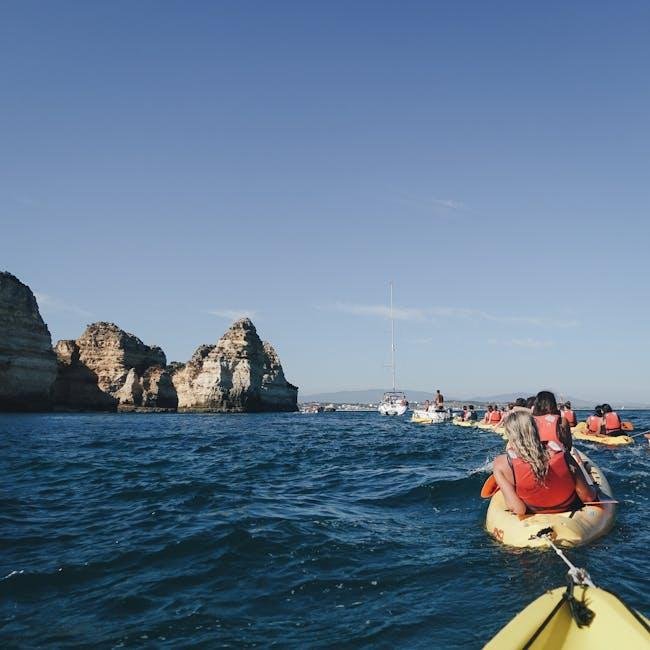when it comes to exploring serene lakes, winding rivers, and the breathtaking coastline, kayaks offer an unparalleled way to connect with nature. Yet,as any seasoned paddler knows,not all kayaks are created equal. The choice between touring kayaks and recreational kayaks can feel daunting, especially for those new to the sport. While both types promise adventure and a chance to embrace the great outdoors, they are designed with different purposes in mind, catering to a range of experiences, skill levels, and water conditions. In this article, we’ll delve into the unique features and benefits of touring and recreational kayaks, helping you navigate the waters of decision-making.Whether your an aspiring adventurer eyeing a multi-day journey or a casual paddler seeking a day of fun on the lake, understanding the distinctions between these two kayak categories will empower you to choose the craft that best fits your paddling dreams. Join us as we embark on this journey of exploration and revelation, ensuring that your next kayaking experience is nothing short of extraordinary.
Exploring the Design Differences Between Touring and Recreational Kayaks
When diving into the world of kayaks, one quickly encounters two primary styles: touring and recreational.Touring kayaks are designed for long-distance travel on open waters and typically feature a longer, narrower hull. This design enhances speed and efficiency, making them ideal for extended journeys.They frequently enough come with additional storage compartments, which allows paddlers to carry essential gear for multi-day expeditions. Here are some key characteristics:
- Length: Generally 12 to 18 feet for stability.
- Weight Capacity: High, accommodating larger loads.
- Rudder or Skeg: Common for improved tracking in water.
On the other hand, recreational kayaks are built for short trips and leisurely paddling on calm waters like lakes and rivers. They have a wider hull, offering greater stability and maneuverability, which is perfect for beginners or casual paddlers. Their shorter length and lighter construction make them easier to transport and handle. Key features include:
- length: Typically 8 to 12 feet for easy navigation.
- Weight Capacity: Moderate, suitable for basic outings.
- No rudder: Generally equipped with a straightforward design.
Below is a simple comparison table to summarize their distinct features:
| Feature | Touring Kayaks | Recreational Kayaks |
|---|---|---|
| Hull Design | Narrow,streamlined | Wide,stable |
| Usage | Long-distance trips | Leisurely paddling |
| storage | Ample compartments | Minimal storage |

Assessing Performance: Speed, Stability, and Navigation
When evaluating kayaks for touring versus recreational purposes, speed is a critical factor. Touring kayaks are designed for longer distances and frequently enough feature a sleek, elongated hull that allows them to slice through water efficiently. This streamlined design typically results in a better top speed compared to recreational models, which tend to be shorter and wider for enhanced stability. Enthusiastic paddlers may appreciate the different hull shapes such as:
- Length: Touring kayaks frequently enough exceed 12 feet, promoting faster travel.
- Shape: A pointed bow enhances hydrodynamics.
- Materials: Lightweight fiberglass or composite materials contribute to speed.
Stability and navigation play pivotal roles in user experience, particularly for beginners. While recreational kayaks boast a wider base, providing excellent secondary stability, touring kayaks emphasize directional tracking, making them better suited for navigating open waters. Recreational models are easier to maneuver in tight spaces, perfect for lakes and rivers with obstacles. A comparison of their features illustrates these differences:
| Feature | Touring Kayaks | Recreational Kayaks |
|---|---|---|
| Speed | High due to streamlined design | Moderate, built for casual use |
| Primary Stability | Less stable, requires skill | Wide base for enhanced stability |
| Navigation | Excellent tracking on open waters | Easier to maneuver on rivers and lakes |
Comfort and Features: Choosing the Right Kayak for Your Adventure
When embarking on a kayaking adventure, the level of comfort you experience can greatly influence your overall enjoyment. Touring kayaks are designed for long-distance paddling and often feature ergonomic seat designs with ample adjustability. This ensures that you can maintain a pleasant position even during extended outings. in contrast, recreational kayaks tend to focus more on stability and ease of use, making them perfect for shorter, casual excursions. Some common features to consider include:
- Seat Comfort: Look for padded, adjustable seats that offer support.
- Stability: Wider beams in recreational kayaks provide a more stable platform.
- Storage Space: Touring kayaks typically have ample storage compartments for multi-day trips.
- Accessibility: Recreational kayaks frequently enough have larger cockpits for easy entry and exit.
In terms of features, both kayak types offer unique advantages tailored to different experiences on the water. Touring kayaks often come equipped with additional gear storage, allowing for longer adventures with all the essentials close at hand. They might also include rudders or skegs which improve directional stability, particularly in unpredictable conditions. On the other hand, recreational kayaks prioritize fun and simplicity, usually featuring lightweight designs that make them manageable and swift to set up. Below is a comparison table illustrating key features:
| feature | Touring kayaks | Recreational Kayaks |
|---|---|---|
| Seat Comfort | Ergonomic, adjustable | Basic padding |
| Storage Capacity | High capacity for long trips | Limited space for quick outings |
| Weight | Generally heavier | Lighter and easy to carry |
| Best Use | Long-distance paddling | Casual, short trips |
Making the Right Choice: Matching Kayaks to Your Paddling Goals
Choosing the right kayak can be a transformative decision in your paddling journey. Each type of kayak has distinct features and benefits that cater to different paddling adventures. touring kayaks are designed for those who seek longer expeditions and are typically elongated, offering better tracking and speed. Their sleek design frequently enough accommodates storage for extended trips and can tackle various conditions with ease. In contrast, recreational kayaks are perfect for casual outings, providing stability and comfort over short distances. Their wider hulls offer a more forgiving experience, making them great for beginners or family outings on flat water.
When matching a kayak to your paddling aspirations, consider the following elements:
- Length and Stability: Touring kayaks (12-18 feet) vs. recreational kayaks (8-12 feet)
- Purpose: Long explorations vs.fun day trips
- Water Conditions: Suitable for lakes,rivers,or ocean paddling
- Gear Storage: Essential for multi-day trips or day paddling
To further clarify your options,here’s a simple comparison table:
| Feature | Touring Kayaks | Recreational Kayaks |
|---|---|---|
| Length | 12-18 feet | 8-12 feet |
| Speed | high | medium |
| Stability | Moderate to High | High |
| Storage | Ample | Limited |
Future Outlook
As we paddle towards the conclusion of our exploration into the world of touring and recreational kayaks,it’s clear that the choice between the two ultimately boils down to your individual preferences and paddling aspirations. Touring kayaks, with their sleek designs and long-distance capabilities, beckon adventurers looking to embark on grand journeys across serene lakes and winding rivers. Conversely, recreational kayaks offer a more laid-back experience, perfect for leisurely outings and spontaneous weekends on the water.
Both types of kayaks have their unique charms and functionalities. Whether you seek the thrill of navigating uncharted waterways or the simple joy of gliding across a calm bay, the right kayak can enhance your time on the water. As you weigh the advantages of each option, consider your skill level, the environments you wish to explore, and how you envision your time spent paddling.
Ultimately, the best choice is the one that aligns with your desires and lifestyle. So, strap on your life jacket, grab your paddle, and let the waves of adventure guide you to the perfect kayak that suits your journey. Happy paddling!
